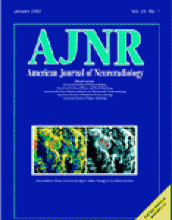Abstract
BACKGROUND AND PURPOSE: Conventional imaging techniques cannot be used to unambiguously and reliably differentiate malignant from benign vertebral compression fractures. Our hypothesis is that these malignant and benign vertebral lesions can be better distinguished on the basis of tissue apparent diffusion coefficients (ADCs). The purpose of this study was to test this hypothesis by using a quantitative diffusion imaging technique.
METHODS: Twenty-seven patients with known cancer and suspected metastatic vertebral lesions underwent 1.5-T conventional T1-weighted, T2-weighted, and contrast-enhanced T1-weighted imaging to identify the lesions. Diffusion-weighted images of the areas of interest were acquired by using a fast spin-echo diffusion pulse sequence with b values of 0–250 s/mm2. The abnormal regions on the diffusion-weighted images were outlined by using the conventional images as guides, and the ADC values were calculated. On the basis of pathologic results and clinical findings, the cases were divided into two categories: benign compression fractures and metastatic lesions. The ADC values for each category were combined and plotted as histograms; this procedure was followed by statistical analysis.
RESULTS: The patient group had 12 benign fractures and 15 metastases. The mean ADC values, as obtained from the histograms, were (1.9 ± 0.3) × 10−4 mm2/s and (3.2 ± 0.5) × 10−4 mm2/s for metastases and benign fractures, respectively.
CONCLUSION: Our results indicate that quantitative ADC mapping, instead of qualitative diffusion-weighted imaging, can provide valuable information in differentiating benign vertebral fractures from metastatic lesions.
- American Society of Neuroradiology












